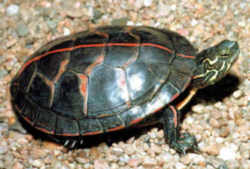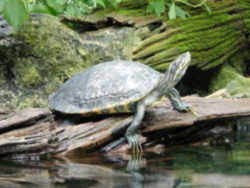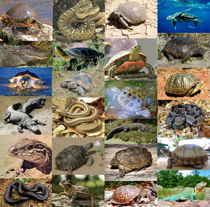
Vermont Symbols
Vermont State Reptile
Painted Turtle

(Chrysemys picta)
Adopted on May 16, 1994
Needing no signature by Governor Howard Dean, the painted turtle, (Chrysemys picta,) became the state reptile of Vermont on May 16, 1994.
State Senator Elizabeth Ready introduced the Senate joint resolution, J.R.S 57, on January 11, 1994.
Behind the adoption of the painted turtle as the state reptile of Vermont, we find elementary school students from the Cornwall School (Anna Sunderland Stowell Bingham Memorial School) in Cornwall, Vermont.
According to the resolution J.R.S 57, the painted turtle was adopted because:
- the turtle is hard worker and can withstand cold temperatures like the citizens of Vermont;
- colors represent the beauty of our state in autumn;
- adds to the state's natural diversity;
- iadds to the beauty of our ponds;
- helps control insect pests; and
- one of the most common turtles in Vermont.
Vermont State Reptile: Painted Turtle

Painted turtles are brightly marked. They have a smooth shell about 90 to 250 mm long. Their shell acts as protection, but since the ribs are fused to the shell, the turtle cannot expand its chest to breathe but must force air in and out of the lungs by alternately contracting the flank and shoulder muscles. The painted turtle has a relatively flat upper shell with red and yellow markings on a black or greenish brown background. Males mature at about 70 to 95 mm plastron (lower shell) length, usually at 3 to 5 years of age. Females at take longer (6 to 10 years) and are larger at maturity (c. 100 to 130 mm plastron length). The growth rate, for both sexes is rapid during the first several years of the of their lives. Turtles continue to grow slowly after maturity, and this species may reach 250 mm carapace (upper shell) length and live for many decades.
Behavior
Painted turtles bask in large groups on logs, fallen trees, and other objects. The sunning helps rid them of parasitic leeches. In many areas turtles hibernate during the winter months by burrowing into the mud and allowing their bodies to become very cold. Because of their small body size, they can move easily. Turtles dive quickly at the first hint of danger. Painted turtles are diurnal; that means they are active during the day. At night they will rest on the bottom of a pond or on a partially submerged object, such as a rock. During the day, painted turtles will bask in the sun, sometimes as many as 50 on one log, stacked on top of each other.Habitat
The turtles' environment includes a unique blend of niches from wetlands, to uplands, to sand sites. Each niche is important to satisfy the separate living, breeding, and feeding requirements of Michigan turtlesReproduction
Mating begins after hibernation and before feeding begins when the water temperatures are still low. Fall mating may also occur. Temperature is a major environmental cue for the regulation of the seasonal gonadal cycle, but the thermal dependence of the reproductive system differs markedly for the two sexes.
Vermont Joint Resolution No. R-179
NO. R-179. JOINT RESOLUTION RELATING TO THE DESIGNATION OF THE PAINTED TURTLE AS THE STATE REPTILE.
(J.R.S. 57)
Offered by: Senator Ready of Addison County.
Whereas, the Painted Turtle is a hard worker and can withstand cold temperatures like the citizens of Vermont, and
Whereas, the colors of the Painted Turtle represent the beauty of our state in autumn, and
Whereas, the Painted Turtle adds to the diversity of Vermont's habitat, and
Whereas, ponds are an attractive part of Vermont's landscape and the Painted Turtle adds to that beauty, and
Whereas, Painted Turtles help control the number of insect pests in Vermont, and
Whereas, the Painted Turtle is one of the most common turtles in Vermont, now therefore be it
Resolved by the Senate and House of Representatives:
That the General Assembly hereby recognizes the Painted Turtle as the official state reptile, and be it further
Resolved: That the Secretary of State is directed to forward a copy of this resolution to the students of Cornwall Elementary School inasmuch as their
efforts resulted in legislative recognition of this fine reptile.
Vermont Law
The Vermont state reptile was approved by a joint resolution. A Vermont joint resolution is used to "express the sentiments
of the legislature" and does not require the signature of the governor. A joint resolution, as passed to adopt the state reptile, requires the
approval of both the State House of Representatives and the State Senate. Resolutions are not written into the Vermont Statutes and do not carry the
full weight of law.
As of February 23, 2012, the cold and warm water fish and the state reptile are the only Vermont symbols declared by resolution and not written into
the Vermont Statutes.
Taxonomic Hierarchy: Painted Turtle
Kingdom: Animalia - animals
Phylum: Chordata - chordates
Subphylum: Vertebrata - vertebrates
Class: Reptilia
Order: Testudines
Family: Emydidae
Genus: Chrysemys|
Species: Chrysemys picta







